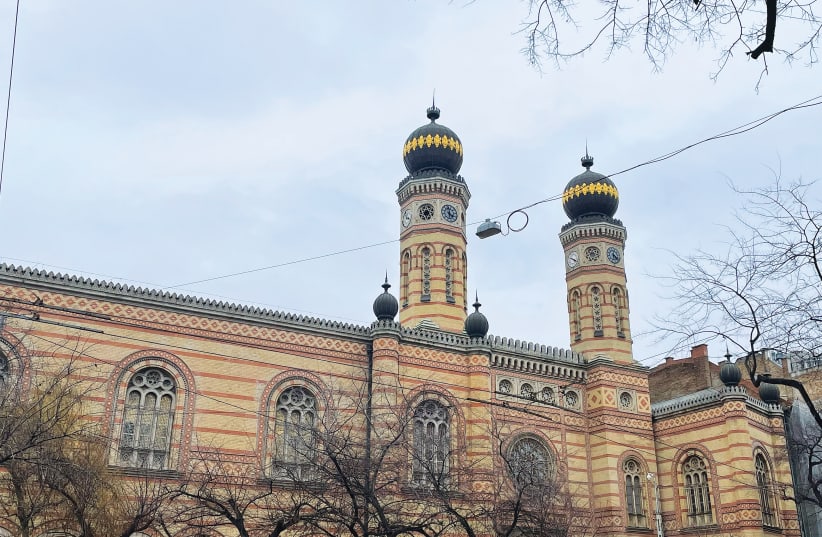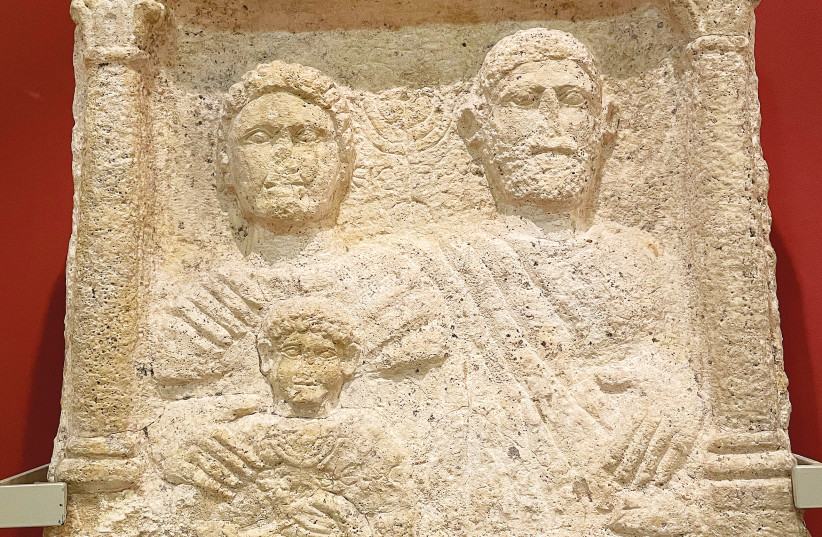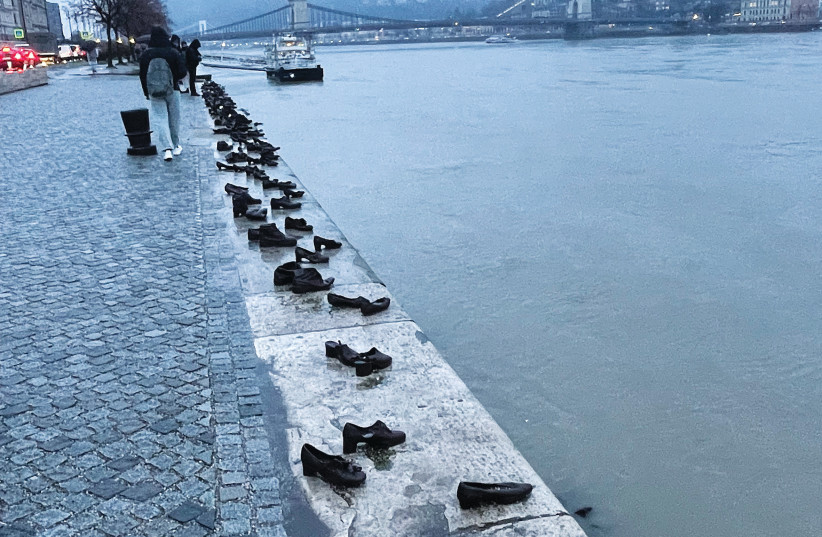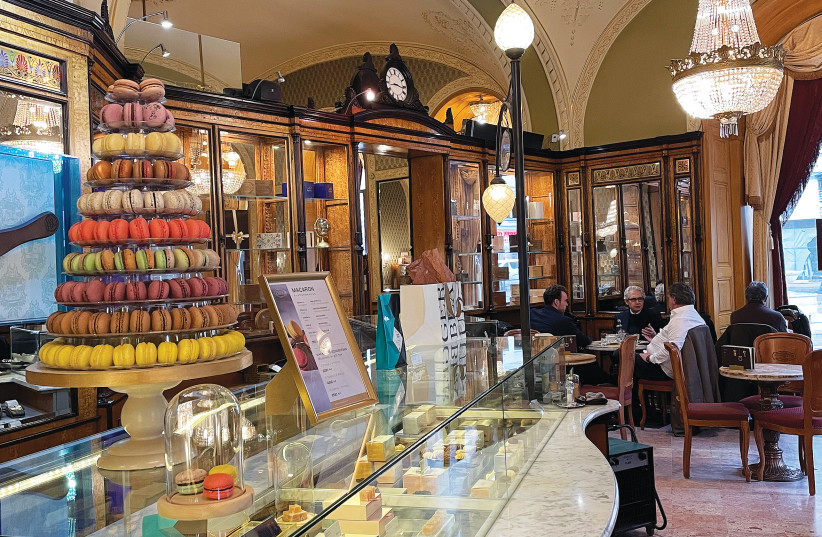Everywhere you look in Budapest, there are ghosts of its Jewish past.
Ancient Jewish tombstones are displayed in the basement of the National Museum.
Sixty pairs of iron shoes line the bank of the Danube, in memory of the Jews murdered there.
Non-kosher restaurants have names like “Mazel Tov” and “Spinoza” and list cholent (sometimes described as “Jewish beans”) on their menus.
The onion-domed Dohány Street Synagogue, built in 1859, is the largest in Europe, seating 3,000 people. It’s the centerpiece of a compound that also includes a Jewish museum erected on the spot where Theodor Herzl’s home once stood.
The synagogue was part of the Jewish ghetto set up by the fascist-led Hungarian government in the final months of World War II. More than 2,000 Jews who died from hunger, cold and disease during the winter of 1944 to 1945 are buried in its courtyard.
The Raoul Wallenberg Holocaust Memorial Park in the synagogue complex is named for the Swedish diplomat who saved thousands of Jews by giving them Swedish passports and sheltering them in buildings he declared to be Swedish territory. He was detained by Soviet agents during the siege of Budapest in January 1945, and then disappeared – his fate still unknown.
The Memorial of the Hungarian Jewish Martyrs in the synagogue courtyard resembles a weeping willow tree, with leaves inscribed with the names of victims. Nearby is a memorial to Hungarian-Jewish secret agent and poet Hannah Szenes, who was executed in Budapest by a Nazi firing squad after parachuting into Yugoslavia.
Budapest - an increasingly popular tourist destination
Budapest is an increasingly popular tourist destination for Israelis drawn by round-trip fares as low as NIS 260 for the three-hour direct flight from Tel Aviv. A room at Budapest’s new Kozmo Hotel and Spa costs as little as NIS 425 per night – versus around NIS 2,500 for a comparable luxury hotel in Tel Aviv. Meals and drinks in Budapest are also a fraction of Israeli prices.
According to Mishpacha, out of Hungary’s 90,000 Jews, only about 30 are religiously observant by Orthodox standards. That’s 30 people – not 30%. Nevertheless, Budapest has a handful of kosher dining options, mostly catering to tourists, such as the Carmel Restaurant and the Hanna Garden Bistro.
Budapest has long been a center of “Neolog” (liberal/modernist) Judaism and is home to the Jewish Theological Seminary – University of Jewish Studies, founded in 1877 and one of the oldest institutions training non-orthodox rabbis and cantors.
Today, the Jewish Quarter is known as Budapest’s “party quarter,” full of hipster “ruin bars,” clubs, cafés and vintage clothing boutiques.
Jews have a long history in Budapest. One of those tombstones mentioned above dates from the 4th century. Sometime after it was erected, three menorahs were roughly carved into it, along with the Greek inscription “to our deceased son Benjamin.... There is one God.”
Built in 1364, the Medieval Jewish Prayer House, a small, two-room Sephardi synagogue near Buda Castle, re-opened for hassidic-style worship in 2018.
Near the Prayer House are the Budapest History Museum, the Hungarian National Gallery and a fine view of the Danube from the Fisherman’s Bastion.
The Museum of Fine Arts has many works of Jewish interest, including a vibrant painting by Artemisia Gentileschi of Jael driving a tent peg into the head of the Canaanite general Sisera. (Judges 5:24-31.) Jael was modeled on the artist herself, while Sisera was based on her lover, a Florentine nobleman. (She left him and moved to Rome soon after it was painted.)
The museum’s collection also includes Rembrandt’s The Old Rabbi and a 1503 Hans Baldung Grien painting of Eve (who looks remarkably like Paris Hilton).
For those who prefer less conventional museums, Budapest offers the “House of Terror,” with exhibits related to the fascist and communist Hungarian regimes and their victims who were held, interrogated, tortured or killed in the building.
Budapest also has the world’s largest light museum, along with a pinball museum, a Houdini magic museum and a Lego art exhibit.
After a chilly day of sightseeing, it’s delightful to visit one of Budapest’s many baths.
The most famous are the art deco Gellért Baths, built in 1918. The labyrinthine building includes swimming pools, saunas, steam rooms hot enough to cook broccoli, and mineral baths of various temperatures.
Guests pay for either a locker or a dressing room “cabin,” with prices from NIS 90 to 113 for an all-day pass.
The baths are popular with wannabe influencers in string bikinis and full makeup, recording themselves with iPhones held just above the waterline. (The gift shop sells waterproof phone pouches for the risk averse.)
The main pedestrian shopping street of Budapest is Váci utca. Many shops sell plastic tourist trinkets or are international chains like Zara. However, a little store at 73 Váci utca sells antique prints and maps for very reasonable prices. Just around the corner at 12 Régiposta utca, the Folkart Craftsman’s House sells authentic (and expensive) Hungarian crafts, including beautiful felt appliqué work.
Another popular shopping destination is the cavernous Central Market Hall. The main floor stalls sell meat, salami, paprika, honey and produce. In the tourist-packed upstairs, vendors sell T-shirts, more plastic souvenirs and street-food eaten standing up.
According to our cab driver (who said he’d never set foot in the Central Market Hall), Hungarian food is meant to be eaten sitting down. Some of the nicest places to do that are Budapest’s historic cafés.
The eclectic Italian Renaissance-style New York Café, opened in 1894, claims to be the most beautiful café in the world. The Gerbeaud Café, in a square at one end of Váci utca, opened in 1858 and is similarly grand.
The “Hungarian Classics” plate at Gerbeaud features a Gerbeaud slice (ground walnuts, apricot jam, dark chocolate coating), Esterházy cake (walnut cake, vanilla cream flavored with brandy), Dobos cake (sponge cake, chocolate crème pâtissière, hard caramel topping), and vanilla ice cream for about NIS 50. A Gerbeaud coffee includes apricot liqueur and is topped with whipped cream.
Although many Israelis plan breaks in warmer locales like Eilat and the Sinai, Budapest is a romantic, affordable destination for a long winter weekend.




